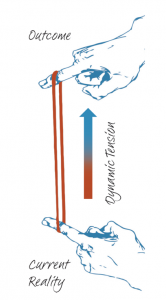By: Anne Lancaster, Business Advisor
Feeling overwhelmed? Exhausted?
 2020 has been a year of accentuated anxiety, seemingly endless stress, and unparalleled uncertainty.
2020 has been a year of accentuated anxiety, seemingly endless stress, and unparalleled uncertainty.
Keeping a positive outlook can be challenging with daily updates of COVID-19; local, state, and federal mandates; personal and professional changes. We live with this dynamic tension ALL the time. It’s natural, it’s real, it’s everpresent.
How we deal with this tension makes all the difference.
We can react to this tension with fear OR we can respond to this tension with a choice.
Adapted from David Emerald’s Power of TED* and the 3 Vital Questions, below are 5 steps you can take at any moment in time to move you forward.
Step 1: What is your Current Reality?
Whether it’s a task, relationship, or situation ask yourself “What is my current reality?” Aspects of the current situation to consider may include:
→ objective facts (time, money, age, education, relationships…)
→ feelings not labeled as good or bad, just that they exist
→ skills and abilities of self and others
→ the observable behavior of self and others
State the truth about where you are at this current time. Use words that are honest, nonjudgmental, neutral, and objective. Is your business stalled? Shut down? Running at half the capacity from 2019? Are you working remotely 24/7? How has COVID-19 changed your work-life balance? List all that is happening in your current reality. Do what I often call a “brain dump” listing all that is in your head on paper.
Example: Since March 2020, my business revenue has declined by 50% from 2019. We have laid off half our workforce and sales are slowly returning. Now Describe your current reality:
Step 2: What outcomes do you want?
There is an important distinction between outcomes and goals. A goal has concrete steps and time frames. Your outcomes are not as specific or detailed as a goal statement. An outcome is a deeper, value-driven statement that helps you create and live a purposeful life. Your outcome can contain many goals (which you will think through later in this process.)
→ What is it you want to create for yourself? If you could have, do, be anything – what would it be?
→ What is your vision? What does success look like? How will you know it? What will it feel like?
→ Do you want more sales? Will you hire more employees? Will you launch a new product/service?
→ Will you expand to a new location? Will you manage your expenses differently?
Example: We want to increase revenue. We want to hire back our employees. We want to introduce a new product by July 2021 and increase our marketing efforts. Now write down all that you want:
Step 3: Who/What is supporting your vision/outcomes?
Often we forget that we have support around us during difficult times. Taking the time to note who and what is supporting your outcomes is step 3. Who is in our corner, day in and day out? Is it your partner, spouse, mentor, colleague, business partner? Don’t forget to list YOU as support!
Example: Current employees are dedicated and committed to working together through this pandemic. The current customer base is loyal and growing. I am fully committed to this business. Vendors are working with us to manage expenses. Write down who your support group is:
Step 4: Who/What is inhibiting your vision?
What is getting in your way of success? What is holding you back? Is there someone who is limiting you moving forward? Sometimes we are our worst enemy. Do you get in your way? Again, just write down what comes to mind – non-judgmental.
Example: Me, I overthink things all the time. I am stuck on what to do next. Uncertain state and federal mandates. CDC requirements. Write down who/what inhibits your vision:
Step 5: What 3 next steps will you do. By when?
This step is what will move you forward. Write down 3 tangible actions that you can take and in a reasonable timeframe. If you have more than 3 items choose the most important at this time. Which possible next steps excite and energize you? Which steps can you get started on right now? The next steps must be doable and 100% yours to do.
Example: 1. Review current financials by the end of next week 2. Review products and their success/failures 3. Do a customer survey as a touch base and inquiry on needs/wants by the end of the year.
This process should leave you feeling a bit less stuck and overwhelmed. It should give you a path forward, which you have control over. Turn to this process weekly, daily or even hourly if that’s what it takes to keep moving forward in a positive and productive way.
Remember change, uncertainty, and stress is ever-present. We live with this dynamic tension (the gap between current reality and outcomes) all the time. It’s the way in which we choose to respond that can make all the difference.
